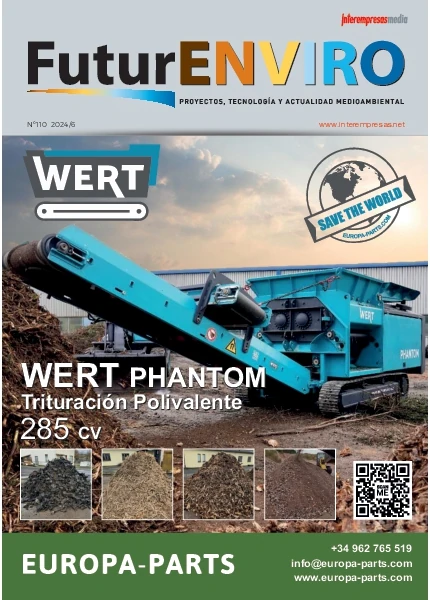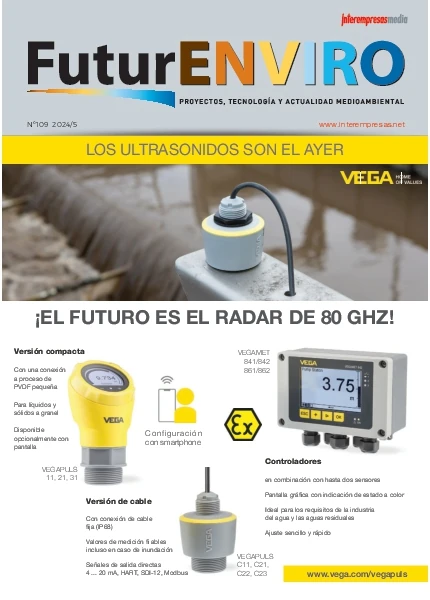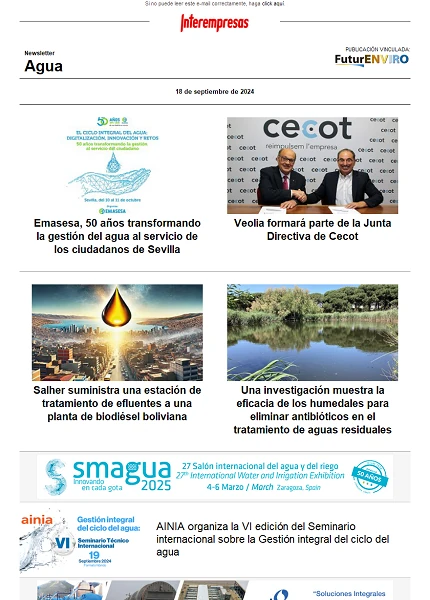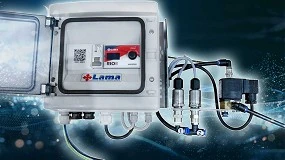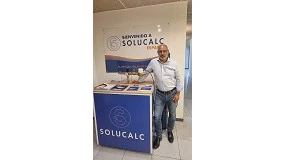Desarrollo de granzas y compuestos plásticos para aplicaciones de altas prestaciones a partir de PET reciclado (RPET)
Gaiker-IK 415/04/2007
Introducción
En la figura anterior se puede ver claramente la tendencia al alza de la recuperación. Este crecimiento se está produciendo de manera exponencial, por lo que cabe esperar que la fuente de PET reciclado (RPET) sea cada vez mayor.
Siguiendo estas tendencias el Centro Tecnológico Gaiker ha llevado a cabo un proyecto cuyo objetivo es la revalorización del RPET, residuo que proviene fundamentalmente de envases y botellas, y convertirlo en un material con unas prestaciones similares al PET virgen reforzado de ingeniería. El proyecto ha contado con la subvención del Ministerio de Medio Ambiente.
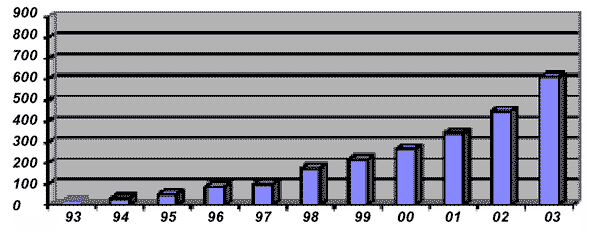
Identificación de aditivos y elaboración de formulaciones
El PET puede ser considerado una materia prima de bajo coste para la producción de compuestos de ingeniería cuando se compara con otro tipo de polímeros. La razón es que es un recurso fácilmente disponible gracias al reciclado de botellas de agua mineral, y que en el futuro lo será aún más debido al desarrollo y proliferación del reciclado de plásticos en todo el mundo.
Sin embargo, este polímero presenta una serie de desventajas comparado con otros termoplásticos de ingeniería cuando la técnica de transformación empleada es el moldeo por inyección. El PET posee una velocidad de cristalización baja, lo que le confiere cierta tendencia a fragilizarse, característica que ha mantenido alejada a esta resina del proceso de inyección. Otros inconvenientes que presenta son su alta sensibilidad a la humedad y baja temperatura de transición vítrea. Sin embargo, tiene un alto módulo mecánico, alta resistencia a la temperatura y brillo superficial, siempre y cuando presente una cristalización adecuada.
Una correcta formulación del compuesto de PET puede evitar los problemas previamente mencionados, mediante el uso de aditivos y cargas. Por ejemplo, la incorporación de fibra de vidrio aumenta la temperatura de transición vítrea y la aleación con otros polímeros mejora la resistencia al impacto drásticamente.
En Gaiker se han desarrollando compuestos de PET inyectables y de altas prestaciones a partir de RPET procedente de recogida selectiva. Los compuestos desarrollados pueden ser empleados como resinas de ingeniería en muchas aplicaciones exigentes, comprobándose que el empleo de envases de PET reciclados como materia prima proporciona un polímero de alta calidad y con alto peso molecular. Además permite reciclar fracciones de RPET con coloración muy alta u otros inconvenientes que impiden un reciclado directo en envases transparentes pero que no suponen ningún problema en aplicaciones opacas como las que normalmente va a encontrar el compuesto de PET como resina de ingeniería.
En las etapas iniciales del proyecto u previamente a las etapas de compounding, se realizó una selección de materiales y una comparativa entre los distintos aditivos y compuestos susceptibles de ser empleados en el desarrollo de las formulaciones. A continuación se mencionan los componentes que se han empleado en el transcurso del proyecto y su influencia en distintas propiedades

Cargas reforzantes
En la siguiente tabla se pueden comparar las propiedades del RPET y de un compuesto elaborado con RPET y fibra de vidrio al 30 por ciento. La fibra empleada ha sido Vetrotex 952 de 4.5 milímetros de largo de Saint Gobain.
Agentes nucleantes
Las sales alcalinas de ácidos carboxílicos de alto peso molecular son muy efectivas como nucleantes de PET. Estas sales pueden ser distribuidas muy homogéneamente y en bajas concentraciones por todo el polímero, lo cual las hace más efectivas.
Los polieteréster también actúan como nucleantes y promotores de cristalización. Son plastificantes líquidos que reducen las fuerzas intermoleculares entre las cadenas de polímero, y que permiten un mayor deslizamiento entre éstas, pudiendo entonces ordenarse de la forma más favorable para la formación del cristal.

Modificadores de impacto
• La naturaleza del elastómero.
• Cantidad de elastómero.
• Tamaño de partícula de la dispersión de elastómero.
• Distancia interpartícula.
Existen modificadores al impacto reactivos y no reactivos. Los primeros son mejores puesto que forman una fase dispersa estable gracias a que están anclados a la matriz de PET. Los modificadores no reactivos pueden dispersarse eficientemente mediante un procesado intensivo, pero tienden a coalescer más tarde. Los modificadores escogidos han sido:
• Paraloid EXL 5136.
• Paraloid EXL 2314.
El primero es un modificador no reactivo, pero es un MBS con un comportamiento muy bueno debido a que da lugar a partículas con un núcleo gomoso de butadieno-estireno, recubierto con una cáscara rígida de metacrilato-estireno. El resultado es un buen comportamiento al impacto sin modificar en gran manera las propiedades mecánicas y térmicas del PET. El segundo es un modificador reactivo acrílico. La combinación de los dos es importante ya que el segundo proporciona un anclaje del elastómero a la matriz del PET, que permite una mejor propagación de las tensiones a todo el material.
A continuación se muestra la mejora producida por estos aditivos en impacto y el efecto de los mismos en formulaciones basadas en RPET. Además del aumento en la resistencia a impacto los cambios observados en el comportamiento a tracción confirman la flexibilidad aportada por este tipo de aditivos.
Agentes de acoplamiento
A continuación se muestra la influencia de estos agentes en las propiedades del material.
Con los aditivos identificados se han elaborado diversas formulaciones empleando la extrusora de doble husillo disponible en el Centro Tecnológico Gaiker. Posteriormente se han inyectado probetas para la ejecución de los ensayos de caracterización, cuyos resultados están recogidos en las tablas anteriores. De esta manera se ha podido definir las propiedades de estos compuestos y determinar la influencia de cada uno de los aditivos. Una vez seleccionados los aditivos que mejores propiedades proporcionan al RPET, se ha especificado la proporción adecuada en las que cada uno debe añadirse para formar el nuevo compuesto.

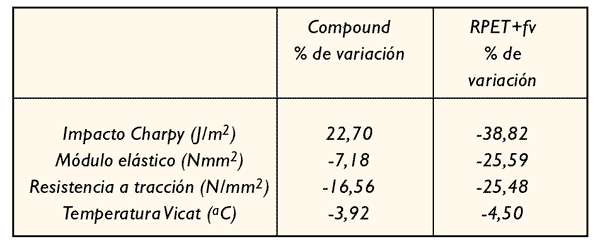
Caracterización y comparación del compuesto formulado
Así, en la extrusora de doble husillo se han obtenido formulaciones en forma de granza, tanto para el compound como para una mezcla de RPET y fibra de vidrio exenta de aditivos. Con estas formulaciones así como con el material comercial (Rynite 530 de DuPont) se han obtenido probetas por inyección que, una vez caracterizadas han servido para comparar unos materiales frente a otros.
En el siguiente cuadro se puede ver como varían las propiedades de las probetas inyectadas con el compuesto creado y con RPET con fibra tomando como referencia las propiedades de las probetas inyectadas con PET comercial.
Como puede observarse la mezcla de RPET y fibra de vidrio presenta una pérdida de características importantes frente al PET comercial. Sin embargo, la adición de aditivos en el compound mejora sustancialmente las propiedades de forma que la pérdida de características en tracción no es tan importante. Incluso el compound supera considerablemente las propiedades a impacto del PET comercial. Así se puede concluir que los aditivos añadidos mejoran claramente las propiedades del PET reciclado.
Una vez comprobada la mejora en probetas a escala piloto se ha seleccionado una pieza para inyectarla con los diferentes materiales: el compound creado en el Centro Tecnológico Gaiker, el RPET reforzado exclusivamente con fibra de vidrio y el PET comercial Rynite. Las piezas inyectadas son cilindros, abiertos por un lateral mientras el otro se encuentra cerrado por una rejilla. Estéticamente, las piezas inyectadas con los diferentes materiales se diferencian entre ellas por el color. Tal y como se puede observar en la siguiente figura, la pieza inyectada con el material comercial adquiere un color crudo, mientras que la inyectada con el compound ofrece un color grisáceo y la inyectada con RPET más fibra de vidrio verde.
Estas piezas se han caracterizado mediante ensayos de compresión y de impacto a bola y han sido sometidas a ensayos de resistencia química, resistencia térmica y envejecimiento. Tras los ensayos se han vuelto a caracterizar y se ha observado el comportamiento que ofrecen las piezas frente a los diferentes tratamientos
Los resultados de los ensayos realizados corroboran la mayor flexibilidad del compound desarrollado en Gaiker frente al producto comercial. Así, las piezas inyectadas con el compound mejoran las propiedades de impacto respecto al material comercial (38,46 por ciento), mientras que disminuyen su resistencia a compresión (25,05 por ciento) Sin embargo, es de señalar que las piezas del compuesto formado por RPET y fibra de vidrio ofrecen unas características similares a las que ofrecen las piezas inyectadas con el material comercial.
El compound, a pesar de ofrecer una menor resistencia a la compresión es capaz de soportar mayor fuerza de impacto, mientras que las piezas de RPET y fibra de vidrio resisten a la compresión de una manera similar que las piezas comerciales y apenas aumenta su capacidad de resistencia al impacto.
Como se ha comentado anteriormente se han sometido a las piezas a distintos tratamientos:
• Envejecimiento: 80 ºC durante 1 semana
• Resistencia térmica: 150 ºC durante 24h
• Resistencia química: inmersión durante 1 semana en distintos medios: aceite y gasolina
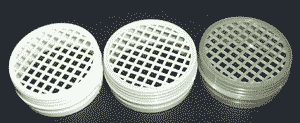
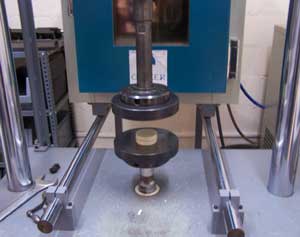
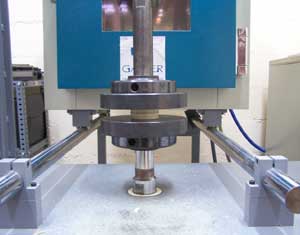
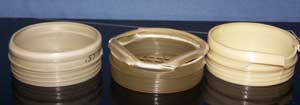
El compound desarrollado parece menos sensible a los tratamientos empleados. Las variaciones más destacables se producen con el ensayo de resistencia térmica, es decir las elevadas temperaturas (150ºC) afectan a las propiedades de las piezas: en el caso del PET comercial y el RPET con fibra de vidrio la resistencia a compresión disminuye en un 10 por ciento mientras que el caso del compound la resistencia aumenta en un 13 por ciento.

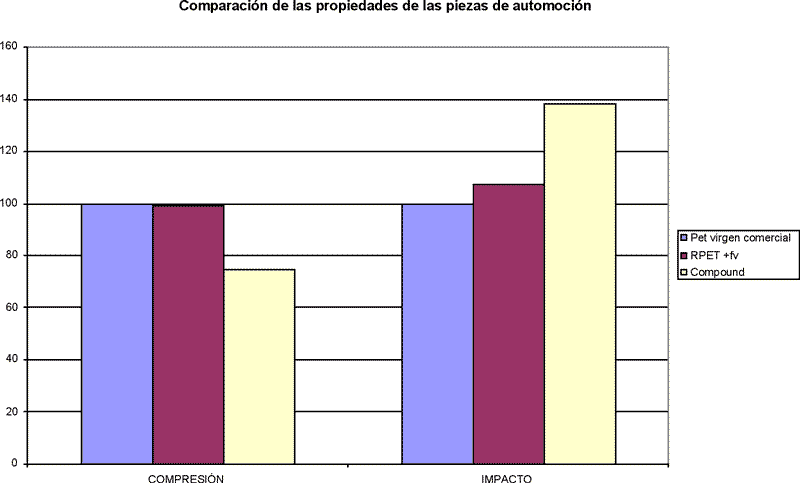
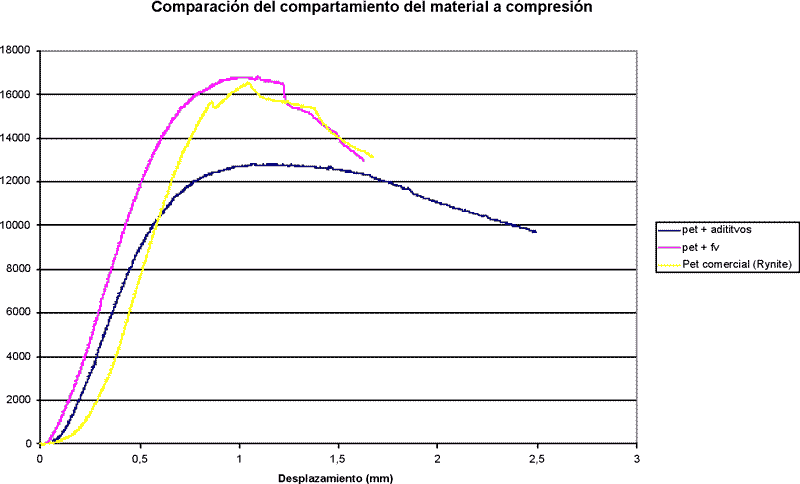
Conclusiones
Esta característica se ve reflejada también en la menor resistencia a compresión que presenta el compound que, en lugar de llegar a rotura como el PET comercial, se deforma con un comportamiento más flexible. Este comportamiento se puede observar en el siguiente gráfico de compresión y en la imagen de la figura 8 que resume los diferentes comportamientos de las piezas
• Las altas temperaturas (150ºC) repercuten en la resistencia a compresión de las piezas.
En el caso del PET comercial y del RPET con fibra de vidrio su resistencia disminuye, mientras que en el caso del compound la resistencia aumenta. Las piezas de compound se vuelven más frágiles y, a pesar de aumentar su resistencia a tracción, su comportamiento a compresión se ve mucho más afectado que el comportamiento del resto de piezas.
• El compound presenta unas propiedades aceptables para el mercado actual tanto en el sector de automoción como en otros tipos de sectores.
Este material mejora algunas de las propiedades del PET virgen comercial, esto supone un valor añadido, ya que el RPET es un material fácil y barato de conseguir y el proceso de fabricación de este material resulta sencillo y económicamente rentable.
Bibliografía
2. Haralabakopoulus, A. A., Tsiourvas, D. and Paleos, C. M., Chain extension of poly(ethylene terephtalate) by reactive blending usind diepoxides, J. Appl. Polym. Sci., 71,2121 (1999).
3. Incarnato, L., Scarfato, P., Di Maio, L. and Acierno D., Structure and rheology of recycled PET modified by reactive extrusion, Polymer, 41, 6825 (2000).
4. Nascimiento, C. R. and Dias, M. L., Poly(ethylene terephtalate) recycling with organic phosphites - I. Increase in molecular weight, J. Polym. Eng., 20, 143 (2000).


